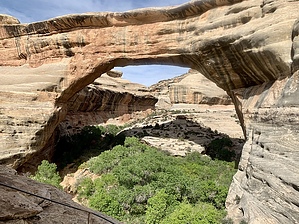| Guide | ♦ | 14 Triplogs | 1 Topic |
details | drive | permit | forecast | route |
stats |
photos | triplogs | topic | location |
| 132 | 14 | 1 |
2nd largest natural bridge in America! by PaleoRob Sipapu Bridge is the largest of the three bridges in Natural Bridges National Monument and the second-largest natural bridge, after Rainbow Bridge, in the United States. The trail to Sipapu is steep and can be very icy during the winter.
After a short descent, the ledge flattens out again, and the trail branches by a beat-up Anasazi granary and a trail register that is no longer used. Continuing along the ledge leads to a point with a nice view of Sipapu Bridge below in the canyon. Following the trail heading down from the trail register will take you to Sipapu Bridge itself. Below the register, the trail goes into a series of steep switchbacks to cross a talus slope. They can be narrow and rocky at times, so watch your footing. When the switchbacks end, you are on a slickrock slope again, with a nice view of Sipapu Bridge looming across the canyon in front of you. The slickrock crossing is the trickiest part of the hike, as it is often steep and can be snowy/icy/slippery during the winter. A seasonal spring occasionally flows during the slickrock crossing, and algae can make this section treacherous even during warmer months when there is no ice. This is an easy place to twist an ankle. The Park Service has installed metal railings for portions of this crossing, and you would be well advised to use them. There are also three log ladders in place to help with steep sections of slickrock and overhangs. They can be slightly unnerving, but rest assured that they are sturdy enough for most people. The final ladder sets you down in a grove of Gambel Oak directly below Sipapu Bridge. Looking up through the leaves is a neat sight. The trail heads towards the center of the bridge, where a sandbar clear of trees allows for a clearer view of the size of the span. Sit back, have lunch, enjoy Armstrong Creek running across the boulders and sand. Done relaxing? Then hit the trail either back to the trailhead or downcanyon on a hike to either Horsecollar Ruin or one of the other natural bridges. While there is a small spring on the slopes above Sipapu and Armstrong Creek runs frequently, it is recommended to fill all your bottles of water at the Visitor's Center. Check out the Official Route and Triplogs. Leave No Trace and +Add a Triplog after your hike to support this local community. | ||||||||||||||||||||||||||||||||||||||||||||||||||||||||||||||||||||||||||||||||||||||||||||||||||||||||||||||||||||||||||||||||||||||||||||||||||||||||||||||||||||||||||||||||||
 Route Editor
Route Editor




